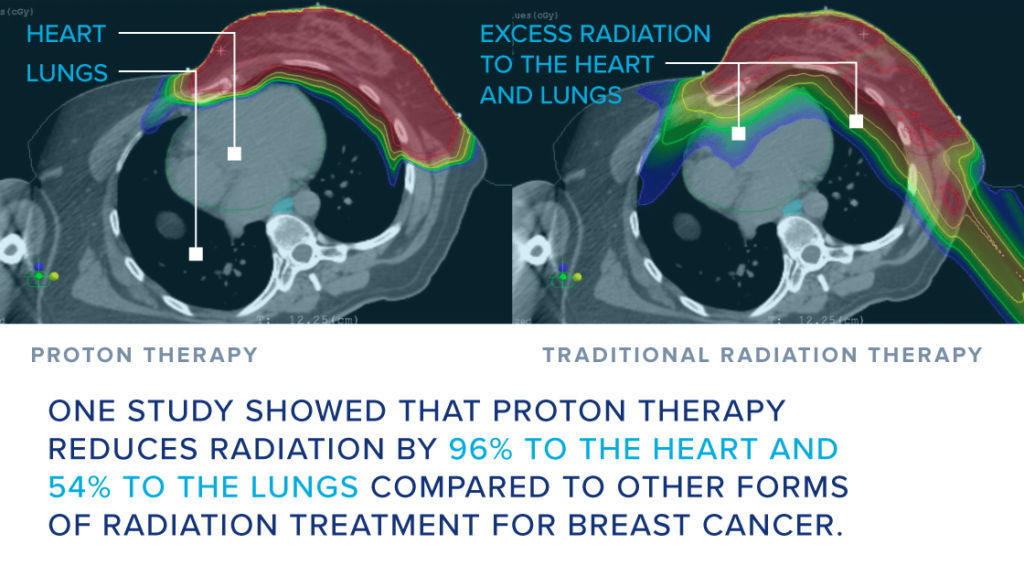Approximately one in eight women will be diagnosed with breast cancer at some point in their lifetime. Breast cancer is the abnormal and uncontrollable growth of the cells lining the breast lobules or ducts. These cancerous cells have the potential to spread, or metastasize, to lymph nodes near the breast or other distant parts of the body, such as the liver, lungs, bones, or brain.
In general, breast cancer treatment typically includes a combination of therapies, such as breast surgery, radiation therapy and medical therapies (chemotherapy, hormone-blocking therapy, and/or immunotherapy).
Diagnosis:
Here’s an overview of how breast cancer is diagnosed and treated:
- Clinical Breast Exam (CBE): Healthcare providers may perform a physical examination of the breasts to check for lumps, changes in breast size or shape, or other abnormalities.
- Mammography: Mammography is a commonly used screening test for breast cancer. It involves taking X-ray images (mammograms) of the breast tissue to detect abnormalities, such as tumors or microcalcifications.
- Breast Ultrasound:Ultrasound uses sound waves to create images of the breast tissue. It can help differentiate between solid masses and fluid-filled cysts.
- Breast MRI:Magnetic resonance imaging (MRI) provides detailed images of the breast and may be used to further evaluate suspicious findings, especially in high-risk individuals.
- Biopsy:If a suspicious lesion is identified through imaging, a biopsy is performed to collect a tissue sample for examination. The biopsy can be done through various methods, including fine-needle aspiration, core needle biopsy, or surgical biopsy.
- Pathology and Tumor Markers: A pathologist examines the tissue samples to determine if cancer is present and, if so, the type and stage of cancer. Tumor markers, such as estrogen and progesterone receptors and HER2/neu status, are often tested to guide treatment decisions.
- Staging: Staging involves determining the extent and spread of breast cancer. This information helps determine the most appropriate treatment plan. Staging may involve additional imaging tests and examination of lymph nodes.
Symptoms
Breast cancer can manifest with various symptoms, but it’s important to note that not all individuals with breast cancer will experience noticeable symptoms, especially in the early stages of the disease. Regular breast cancer screening and self-exams are essential for early detection. Common symptoms and signs of breast cancer may include:
- Breast Lump: The most common symptom of breast cancer is the presence of a new, painless lump or mass in the breast. It may be hard, irregularly shaped, and fixed to surrounding tissues.
- Breast Pain: While breast pain is more often associated with benign breast conditions, it can occasionally be a symptom of breast cancer, particularly if it is persistent and localized.
- Change in Breast Size or Shape: Unexplained changes in the size or shape of one breast compared to the other can be a sign of breast cancer.
- Breast Pain or Discomfort: While breast pain is often not associated with breast cancer, persistent, unexplained breast pain or discomfort should be evaluated by a healthcare provider.
Treatment:
The treatment of breast cancer depends on several factors, including the type of breast cancer, the stage at diagnosis, the presence of specific genetic mutations, the patient’s overall health, and individual preferences. Common treatment options include:
- Surgery:If a suspicious lesion is identified through imaging, a biopsy is performed to collect a tissue sample for examination. The biopsy can be done through various methods, including fine-needle aspiration, core needle biopsy, or surgical biopsy.
- Radiation Therapy: A pathologist examines the tissue samples to determine if cancer is present and, if so, the type and stage of cancer. Tumor markers, such as estrogen and progesterone receptors and HER2/neu status, are often tested to guide treatment decisions.
- Chemotherapy: Staging involves determining the extent and spread of breast cancer. This information helps determine the most appropriate treatment plan. Staging may involve additional imaging tests and examination of lymph nodes.
- Hormone Therapy:
- Targeted Therapy: Targeted therapy drugs, such as trastuzumab (Herceptin), are used for HER2-positive breast cancers.
- Immunotherapy: Immunotherapy may be used in certain cases, particularly for triple-negative breast cancer.
Proton therapy has proven clinical results
Proton therapy may be especially beneficial for breast cancer patients by minimizing damage to nearby tissue and critical organs, such as the heart and lungs. The risk of side effects is also lowered, including reducing the chance of experiencing a cardiac event or developing lung cancer or pneumonitis. Due to the painless and noninvasive nature of proton therapy treatment, you can get back to your daily activities quicker and maintain the same quality of life.
